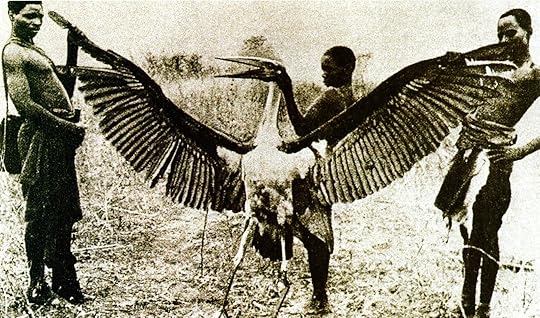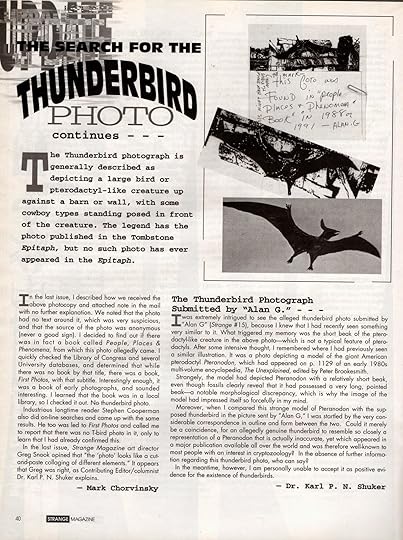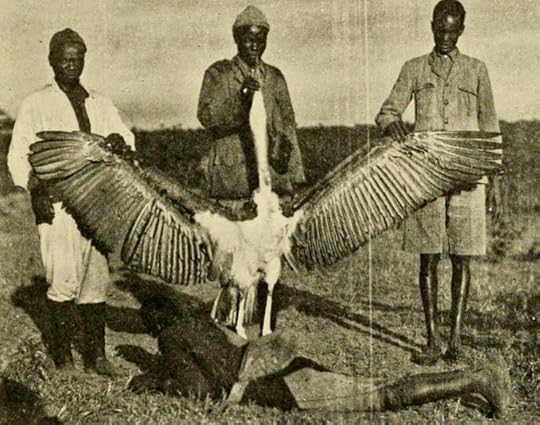SEEKING THE MISSING THUNDERBIRD PHOTOGRAPH - ONE OF CRYPTOZOOLOGY'S MOST TANTALISING UNSOLVED CASES
 Could this very striking photograph of a large marabou stork standing upright with long beak open, huge wings held outstretched, and flanked by human figures have influenced some observers into later believing that they had seen the legendary thunderbird photograph? (public domain)
Could this very striking photograph of a large marabou stork standing upright with long beak open, huge wings held outstretched, and flanked by human figures have influenced some observers into later believing that they had seen the legendary thunderbird photograph? (public domain)One of the most perplexing sagas in the fascinating chronicles of cryptozoology is the long-running search for the thunderbird photograph, supposedly missing, presumed lost, for over a century. Here is an investigation that I conducted quite a while ago with regard to this mystifying picture, which has never previously been published in full, but is presented here now as another ShukerNature exclusive.
THE THUNDERBIRD OF TOMBSTONE
According to traditional Native American Indian lore, thunderbirds were enormous birds of prey that flew through the skies on immense wings, creating thunder when flapping them together, and sometimes even abducting unwary humans. Once dismissed as wholly mythical, many sightings have been made during modern times in the U.S.A., however, notably in the Pacific West and mid-West states, of unidentified yet seemingly gigantic condor-like or vulture-like birds soaring high through the skies and even occasionally encountered perched on the ground, which seem to be veritable 20th/21st-Century thunderbirds.
However, science needs something more tangible than eyewitness accounts to consider before accepting the existence of such astonishing creatures - which is why the thunderbird photograph's history has attracted such interest.
It all (allegedly) began back in 1886, when an Arizona newspaper called the Tombstone Epitaph supposedly published a very striking photograph, which depicted a huge dead pterodactyl-like bird with open beak and enormous outstretched wings, nailed to a barn and flanked by some men. This bird was reputed to be a thunderbird, and judging from the size scale provided by the height of the men standing alongside it, its wingspan appeared to be an awesome 36 ft! In other words, it was three times greater than that of the wandering albatross Diomedea exulans - the bird species currently holding the record for the world's biggest modern-day wingspan.
 A wandering albatross in flight (© J.J. Harrison/Wikipedia; to see more great photos by J.J. Harrison, please subscribe to his Facebook profile
here
)
A wandering albatross in flight (© J.J. Harrison/Wikipedia; to see more great photos by J.J. Harrison, please subscribe to his Facebook profile
here
)Since then, countless people claim to have seen this same photo in various magazines published some time during the 1960s or early 1970s, but no-one can remember precisely where. Those publications thought to be likely sources of such a picture include Saga, True, Argosy, and various of the many Western-type magazines in existence during this period in America, but searches through runs of these publications have failed to uncover any evidence of it.
Nor has anyone come forward with a copy of this photo as published elsewhere, and the archives of the Tombstone Epitaph do not have any copy of it either.
A COUPLE OF HOAXED THUNDERBIRD PHOTOS
A number of photos claimed to be this evanescent, iconic image have been aired over the years, especially online, but these have all been exposed as hoaxes. To keep this section of the present article in proportion to the rest of it, I'll refrain from documenting every one of them here (the subject of a future ShukerNature article instead, perhaps?), and will just confine myself to two representative examples.
The first of these is one that I was personally able to expose, on behalf of Strange Magazine. Below is how it was written up and published in the Fall 1995 issue:
 How I exposed a fake thunderbird photo in Strange Magazine (click image to enlarge it for reading purposes) (© Dr Karl Shuker/Strange Magazine)
How I exposed a fake thunderbird photo in Strange Magazine (click image to enlarge it for reading purposes) (© Dr Karl Shuker/Strange Magazine)The second hoax thunderbird photograph that I'm documenting here, and which is reproduced below, is of much more recent occurrence. Of unknown origin, it seemingly first appeared online in 2011, was rapidly included in numerous websites and blogs devoted to cryptozoology and to mysterious phenomena in general, and engendered much bemusement and controversy as to whether or not it was genuine, particularly as the thunderbird in it was a pterodactyl rather than a bird. Happily, however, when American student and ardent cryptozoological researcher Jay Cooney saw it, he realised that it looked familiar to him, so he conducted an internet image search of pterodactyl models. And sure enough, in one particular online stock-photo library he succeeded in finding a photograph of a model of the late Jurassic pterosaur Pterodactylus (click here to see it) that corresponded precisely with the pterodactyl in the supposed thunderbird photo. The latter's image had been lifted directly from the online stock photo of the Pterodactylus model. Another alleged thunderbird photograph duly discredited. Congratulations to Jay for his astute discovery – click here to access his own full coverage of it in his excellent Bizarre Zoology blog.
 The hoaxed thunderbird photograph exposed by Jay Cooney (creator/s unknown)
The hoaxed thunderbird photograph exposed by Jay Cooney (creator/s unknown) LOOKING FOR THE LOST WITH A SEARCH THROUGH SAGA
While researching for my book In Search of Prehistoric Survivors , published in 1995 and containing a large section dealing with thunderbirds, I decided to conduct some investigations of my own concerning this elusive picture.
I began them by focusing my attention upon Saga. This is an American magazine that has published many cryptozoological articles and illustrations over the years, and was deemed by longstanding thunderbird photo seekers such as the late W. Ritchie Benedict and the late Mark Chorvinsky to be a promising source of such a picture.
As there does not appear to be a complete or even near-complete run of this magazine on file in any British library, I contacted the Library of Congress in Washington DC, whose research specialist, Travis Westly, very kindly agreed to search through every Sagaissue published between January 1966 and March 1969 - a likely period during which this type of photo would have been published in Saga. Alas, no such picture was present, nor even a mention of any type of gigantic mystery bird.
THE THUNDERBIRD PHOTO ON TELEVISION?
Another widely-popularised claim that I decided to pursue is that a copy of the thunderbird photo was displayed on television by American cryptozoologist Ivan T. Sanderson during the early 1970s, when appearing as a guest in an episode of the long-running Canadian series 'The Pierre Berton Show'.
Consequently, I contacted the Audio-Visual Public Service division within the National Archives of Canada, to enquire whether a copy of the Sanderson episode in this series had been preserved. Unfortunately, however, I learnt from research assistant Caroline Forcier Holloway that she had been unable to locate this particular episode, and needed a precise production or release date for it in order to continue looking, because there were 597 episodes in this series still in existence, each of which contained more than one guest. Moreover, there were others that seemed to have been lost, so there was no guarantee that the episode containing Sanderson was among the 597 preserved ones anyway.
 Ivan T. Sanderson on the cover of his book Ivan Sanderson's Book of Great Jungles (© Julian Messner)
Ivan T. Sanderson on the cover of his book Ivan Sanderson's Book of Great Jungles (© Julian Messner)However, one of my correspondents, Prof. Terry Matheson, an English professor at Saskatchewan University with a longstanding interest in the thunderbird photo, claimed in a letter to me of 22 September 1998 that Sanderson appeared on 'The Pierre Berton Show' not in the early 1970s, but actually no later than the mid-1960s. This is because Prof. Matheson vividly remembered seeing this episode and talking about it afterwards with a friend with whom he was working on the Canadian Pacific Railway as a summer job, and he only worked there from 1965 to 1967. Here is what he wrote:
"The particular episode of the programme...did not take place in the early 1970s. I remember watching the segment dealing with the thunderbird - part of an extended interview Pierre Berton had with Ivan Sanderson - from my home, when I was an undergraduate student at the University of Winnipeg in the mid-1960s. By the 1970s I was in graduate school in Edmonton. I know the programme could not have aired much later than 1965, because I recall discussing it initially with my mother and grandmother, who had also watched the show; with college friends, who made me the subject of much good-natured ridicule; and sometime later with a friend from Calgary whom I had met while employed on the Canadian Pacific Railway, as I was (over the summer months) from 1965 to 1967. I cannot recall the precise date of this conversation with my railroad friend, nor can I recollect the date I watched the programme with pinpoint accuracy, but would guess that it aired the winter before my first summer on the railroad, that is, 1964-65; at the very latest, the following year (1965-66). That might be a good place to start."
Prof. Matheson's confident placing of his well-remembered conversations concerning the above TV show within the mid-1960s, coupled with his precisely-dated period of employment on the railway in the 1960s, as well as his undergraduate studies also occurring exclusively in the 1960s, would certainly seem to disprove previous assumptions that this particular show was not screened until the early 1970s - unless, perhaps, it was re-screened at that time, following its original screening in the mid-1960s? However, his letter also contained another notable challenge to traditional assumptions regarding this show:
"To the best of my recollection, the photograph was not shown, at least not on this particular programme. I definitely recall Sanderson's allusions to the photograph, which he described vividly and with great precision. Although I can envision Sanderson's description as if it were yesterday - the bird nailed to the wall of the barn, the men standing in a line spanning the wingspan, etc - he did not, however, have the photograph in his possession when the interview took place, although he certainly claimed to have seen it. Incidentally, some time after this, Sanderson set up a society for the investigation of paranormal phenomena [SITU - the Society for the Investigation of The Unexplained]. I joined, and in response to my inquiry about the photograph, was told that they did not have a copy. Receiving this news led me to wonder at the time if the photograph might be an example of an urban myth or legend."
If, as would now seem to be the case, the thunderbird photo was not shown by Sanderson on 'The Pierre Berton Show' after all, one of the most promising avenues for tracing it - by seeking an existing copy of this specific show - has gone.
URBAN FOLKLORE, OR FALSE MEMORY SYNDROME?
Perhaps, therefore, as sceptics have often suggested, the thunderbird photo has never existed at all, and should therefore be dismissed as nothing more than an example of urban folklore. Having said that, there are others, including myself, who wonder whether at least some of those people who claim to have seen it have actually seen a superficially similar picture, depicting some large but known species of bird with wings outstretched, and years later have mis-remembered what they saw, erroneously believing that they had actually seen the thunderbird photo. Such an event would be a classic case of false memory syndrome.
Interestingly, one photograph that could certainly have inspired people to believe that they had seen the genuine thunderbird photo is one of a large marabou stork held with its beak open and its massive wings outstretched by some native men, reproduced at the beginning of this present ShukerNature post and again below. Tellingly, it appeared in a number of popular books worldwide during the early 1970s, including none other than the Guinness Book of Records, which at that time was second only to the Bible as the world's bestselling book, so was certainly seen by a vast number of people around the globe.
 The iconic – and highly influential? – marabou stork image (public domain)
The iconic – and highly influential? – marabou stork image (public domain)I first proposed the marabou stork picture as a possible false memory trigger in relation to the real thunderbird photo (always assuming, of course, that the latter image really does/did exist!) way back in 1993 - in a letter sent to Bob Rickard at Fortean Timeson 15 February 1993 and in one sent to Mark Chorvinsky at Strange Magazine on 2 July 1993. My letter to Mark was subsequently published by Strange Magazine in its Fall/Winter 1993 issue (for a comprehensive Strange Magazine article of mine on this same subject, check out its December 1998 issue) . Here is what I wrote in my letter:
"Numerous people around the world believe that at one time or another they have seen the notorious "missing thunderbird photograph," allegedly published within a Tombstone Epitaph newspaper report in 1886 (see Strange Magazines #5, 6, 7, 11). In view of its extraordinary elusiveness, however, in many cases it is much more likely that their assumption is founded upon a confused, hazily recalled memory of some other, superficially similar picture instead – i.e. a "lookalike" photograph. A particularly noteworthy "lookalike" for the missing thunderbird photograph appeared on p. 35 of the British version of the Guinness Book of Records (19thedition, published in 1972), and is reproduced alongside this letter of mine. It depicts a large African marabou stork Leptoptilus crumeniferusstanding upright with its extremely large wings (which can yield a wingspan in excess of 10 ft.) held outstretched by some native tribesmen flanking it, and with its startlingly pterodactyl-like beak open wide. This picture thus incorporates a number of features supposedly present in the thunderbird photograph – a very big bird with a pointed pterodactyl-like head, and an extremely large wingspan, whose wings are outstretched, and flanked by various men. Bearing in mind that the photo is a very old one (possibly dating back to the first half of this century [i.e. the 20th Century]), and also that the Guinness Book of Records is a worldwide bestseller, and that this photo might well have appeared not only in the English version but also in many (if not all) of this book's other versions around the world [as far as I am aware, the same picture layout does indeed appear in all versions worldwide within any given year], it is evident that countless people will have seen it over the years, of which some may well have been unconsciously influenced by its striking (indeed, archetypal) image when contemplating the issue of the missing thunderbird photograph."
It is not even the only such photo of a marabou stork in existence either. Below is a second, albeit slightly less evocative one, which appeared in a book by Richard Tjader entitled The Big Game of Africa, and published in 1910:
 Another photo of a marabou stork held with wings outstretched, this time from Richard Tjader's book The Big Game of Africa (public domain)
Another photo of a marabou stork held with wings outstretched, this time from Richard Tjader's book The Big Game of Africa (public domain)Returning to Prof. Matheson's letter to me, he raised an equally thought-provoking but very different point concerning false memory syndrome and the thunder bird photo:
"Although your suggestion that people's memories of a similar photograph might have been confused with that of the thunderbird is entirely possible, as I'm sure you know, Sanderson was a great raconteur, a man whose verbal gifts could cause anyone to imagine that they had actually seen something he had only described in words. Indeed, many years after watching the programme, I met an individual who had also seen the Berton interview and was initially positive that the picture had been shown."
Yes indeed, the power of verbal suggestion. Wars have been instigated as a result of the mesmerising oratory skills of certain leaders, let alone belief that a picture had been shown on a television programme when in reality no such appearance had occurred.
Incidentally, the December 1997 issue of Fortean Times not only contained a detailed account of modern-day thunderbird reports by veteran American cryptozoologist Mark Hall but also included a succinct account of my suggestion that the marabou stork photo in the Guinness Book of Records 1972 edition may have influenced some people in their belief that they had seen the missing thunderbird photo. Deftly combining our separate contributions to the subject, this issue's front cover duly sported a breathtaking illustration by artist Steve Kirk of a marabou stork-inspired thunderbird!
 The spectacular marabou stork-inspired thunderbird artwork gracing the cover of the December 1997 issue of Fortean Times (© Steve Kirk/Fortean Times)
The spectacular marabou stork-inspired thunderbird artwork gracing the cover of the December 1997 issue of Fortean Times (© Steve Kirk/Fortean Times)GOING BACK TO THE VERY BEGINNING OF THE MYSTERY
Elsewhere in his letter, Prof. Matheson mentioned a line of investigation of his own that he had conducted in relation to the thunderbird photograph, and highlighted a fascinating and extremely pertinent fact, but one that seems to have attracted little or no attention from other investigators. What he did was to go right back to the starting point of the entire mystery – by writing directly to the Tombstone Epitaph, and enquiring whether such a picture had indeed ever appeared in their newspaper:
"In an interesting reply, they both denied any knowledge of the picture and also pointed out that the reproduction of photographs in newspapers was at that time – the late nineteenth century – not common anywhere in North America. In checking our local newspaper – the Winnipeg Free Press – to see if this was the case, I found that photographs rarely if ever appeared before the early 1900s, at least in that newspaper."
So is the thunderbird photograph fictitious, illusive rather than elusive, nothing more than a fable of our times, perpetuated into the present day by false memory syndrome – inspired in turn by visual lookalikes and seductive verbal suggestion?
Or, against all the odds, might it truly be real? Could there actually be a missing thunderbird photo, concealed in some old, yellowing magazine somewhere?
Next time that you clean out your attic and find a pile of dusty mags there, have a look through them before you throw them out – just in case. You never know what you may discover inside! And needless to say, if you do find the thunderbird photograph, be sure to contact me and let me see it!
I wish to dedicate this ShukerNature blog post to the memory of the late Mark Chorvinsky, the founder and editor of Strange Magazine and a wonderful friend to me, whose encouragement, friendship, and support during my formative years as a cryptozoological researcher and writer boosted my confidence and credibility enormously. Thank you always, Mark.
For plenty of additional information concerning putative modern-day thunderbirds, be sure to check out my book In Search of Prehistoric Survivors .

Published on November 25, 2014 02:24
No comments have been added yet.
Karl Shuker's Blog
- Karl Shuker's profile
- 45 followers
Karl Shuker isn't a Goodreads Author
(yet),
but they
do have a blog,
so here are some recent posts imported from
their feed.



